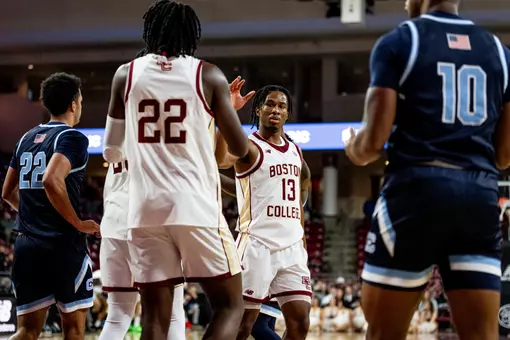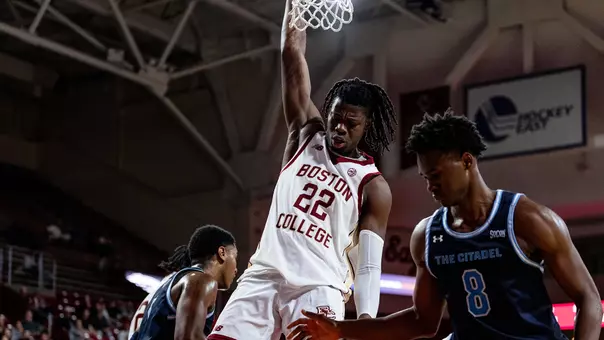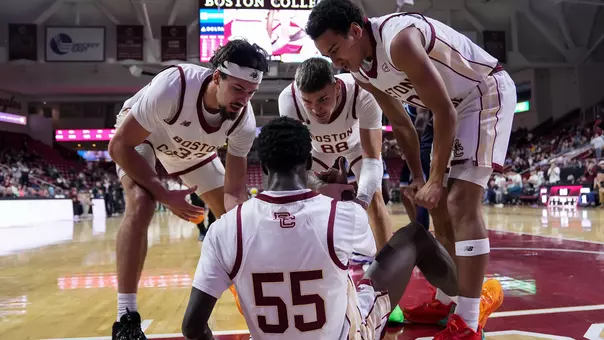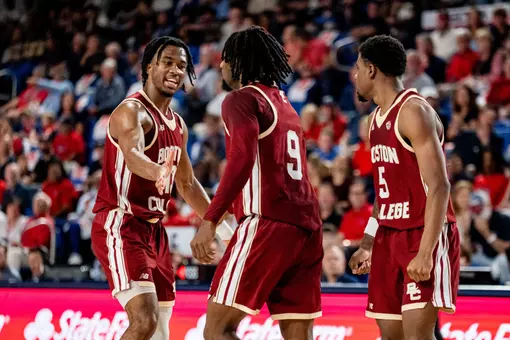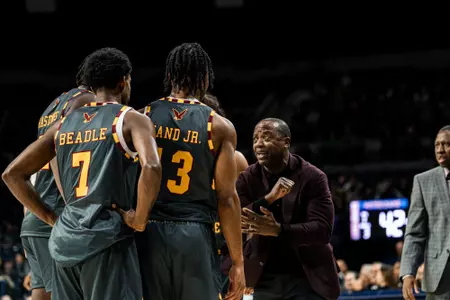
Photo by: Eddie Shabomardenly
Thursday Three-Pointer: Jan. 16, 2025
January 16, 2025 | Men's Basketball, #ForBoston Files
A frustrating loss to Notre Dame yielded another extended break before #3 Duke arrives at Conte Forum
CHESTNUT HILL, Mass. -- On paper, Boston College and Notre Dame aren't historic or natural rivals on the basketball court.
Neither rank among the other's most-played opponents, and neither program's history book dips into the debate or discussion surrounding the more recognizable football matchups from the 1990s and early-2000s. Neither strayed far from their regional roots until Notre Dame joined the Big East in 1995, and both were more likely to play games against programs from their local footprint. For the Fighting Irish, games against Chicago-based DePaul or Milwaukee's Marquette appeared opposite the Eagles' games against Providence, Holy Cross and Villanova, so their more natural pathway didn't appear until the years after they found their way into the Atlantic Coast Conference.
That didn't stop the ACC from pairing the Eagles and Irish together as permanent crossover rivals in the era before Cal, Stanford and SMU expanded the conference to 18 teams, but it also didn't prevent the Fighting Irish from taking a commanding lead in the head-to-head matchup. Two coaching transitions in Chestnut Hill couldn't stop Mike Brey's squad from dominating BC on either team's home court, but the more recent history under Earl Grant flipped the narrative by clinching six of the seven matchups leading into Monday's nationally televised game in South Bend.
Simply put, Grant held Notre Dame's number in the era after the COVID-19 pandemic, but that's why the 78-60 loss at the Joyce Center stung BC at the core foundation of this year's team.
"Every game we've played against Notre Dame has been tight," said Grant. "The difference this year was that they had seven guys from last year, so when we got to that [critical] moment in the second half, those guys had been together and we broke down. We didn't make the plays that we needed to make, and we didn't execute at the level that we needed to execute. They did, and it was simple because their execution was fluid. We got choppy in a tight moment."
Grant long emphasized the nonlinear growth associated with BC's borderline expansion-style roster, but Monday seemingly encapsulated the flaws that arose during several different losses in the early months of the 2024-25 season. The Eagles were competitive for long stretches of the first and second halves, but gaps created by non-cohesive and choppy execution allowed Notre Dame to drive to BC's basket to gain a definitive advantage in foul calls and free throws. BC, meanwhile, failed to generate game flow after being pushed into more one-on-one basketball, and turnover-to-assist ratios cratered whenever the Irish remained a step ahead on either end of the floor.
"I thought we played a great game," said Grant. "Up until the eight minute mark, it was a one-possession game, but Notre Dame got really aggressive. They hit the glass pretty hard, and they beat us on the glass and on ball screen coverages. We made some tough decisions, and they knocked the ball loose on some deflections. Then [Julian] Roper came in and gave them a great lift off the bench with his energy."
The loss left BC in a frustrated state ahead of its week-long wait for Duke, but the extra time created by Monday's loss sets a tone for what to expect from the third-ranked Blue Devils. Unlike Notre Dame, the high-flying style built around center Cooper Flagg placed emphasis on the frontcourt, but the losses to both the Irish and Syracuse exposed the area as an opportunity for improvement.
Here's a look back at the Syracuse and Notre Dame weekend:
1) My recipe for dealing with anger and frustration: set the kitchen timer for twenty minutes, cry, rant, rave, and at the sound of the bell, simmer down and go about business as usual. -Phyllis Diller
I admittedly wasn't thrilled about addressing the technical foul call from the final two minutes of the first half against Notre Dame because I don't believe that the play led directly to BC's unraveling in the second half. I don't think one play or one call is the singular reason why a team wins or loses a game, so addressing one call isn't in my comfort zone or within my overall toolbox. That said, the timing of the call impacted the so-called "middle eight" minutes that surrounded the halftime break, so while I don't love the idea of addressing the call, I'll do my best to break down how it impacted BC's second half struggles.
Let's start with the simplicity of the call itself. Roughly two minutes remained in the first half when officials whistled Chad Venning for a class A technical foul in the aftermath of his hookshot that handed BC a three-point lead. Just 40 seconds earlier, Fred Payne's 3-pointer broke a 25-25 tie by giving the Eagles a 28-25 advantage ahead of free throws by Markus Burton, so handing an additional two free throws and possession to Burton unhinged an intense segment of the half's latter timing.
On pure facts, Burton's additional free throws following the whistle cut the lead back to one, and a subsequent shooting foul by Luka Toews sprung Matt Allocco for a free throw, a miss, an offensive rebound, and a second chance that gave Notre Dame a two-point lead. Four more consecutive points by the Irish extended the lead to six with three seconds on the clock with two of the points coming from free throws after Jayden Hastings committed a shooting foul.
"We had good rhythm," said Grant, "but the technical foul chopped the game up. We went with Jayden Hastings, and he's been really good for us, but he's a young guy who hadn't been in those moments. He looked like a young guy."
The swing didn't torpedo the Eagles by itself, and BC actually ended the half with a buzzer-beating three pointer before taking the lead in the early minutes of the second half. The second foul on Venning, though, proved larger because he absorbed a third foul in the first three minutes of the second half and wouldn't return to the floor before the latter period reached its halfway point. Having gone 3-for-5 from the floor to that point, he hit one more shot after taking the third foul.
None of this layered blame on anyone, but removing Venning from BC's lineup in a game built around physical, blue-collar play within the paint exposed a singular gap on Grant's depth chart by switching the five-on-the-floor to a five-out style better suited for a fast-paced game. Neither Hastings nor Elijah Strong fit the stocky and physical game underneath either team's basket, and the slow-down pace prevented BC from ever utilizing its defensive juices to spark the offensive flow.
2) Why is a carrot more orange than an orange? -Steven Wright
I watch a ton of basketball during a given year, but it never ceases to amaze me when a team loses a game because its style didn't mesh or measure into a head-to-head matchup. The Notre Dame game, to me, matched a BC team built around the ability to play a full-court scheme against the Fighting Irish and their half-court, slow-it-down pace that prevented the Eagles from setting up their offense away from a strong defensive effort.
Let me expound a bit on what I noticed about BC's scheme. When Hastings and Strong are in the game, the Eagles typically employ a more five-out system that allows for faster ball movement and more dribble-drives and kick-out passes. Venning doesn't have the same outside presence, so he's shiftier and more versatile within the painted area.
Utilizing the players within the schemes offers nuance to how BC plays the game. Bringing Venning underneath the basket forced Notre Dame to collapse its defensive post to prevent him from uncontested drives up to the rack, but he also shifted his way back to the mid-post while someone else filtered underneath. Those early second half minutes opened lanes for Strong or the guards to dribble-drive around the region where Venning pulled the defender out, which in turn created easier layups for Joshua Beadle and Strong, who completed an old-fashioned three-point play on BC's second possession of the half.
Forcing Notre Dame to cover those areas opened Hand's outside shot, and Strong was versatile enough to kick himself out to receive those passes. Without Venning underneath, the five-out method created a virtual pack line within the Irish defense, but neither Hastings nor Strong played that particular style to compensate for Venning's physicality. Under no circumstances is that anyone's fault, but it's a reason why the Irish simply kept BC boxed into their style of home court play.
3) You should live the journey. -Coach K
This leads us back to the week ahead. There's a tendency to overcompensate for losses by reinventing the wheel, but I think BC is actually well-suited to compete with Duke by shifting its five-out game into a more four-out, one-in method. The Blue Devils are not a team built to play that big, rugged, Big East style of play, and there's a definite lane for the Eagles to match Cooper Flagg as long as Duke doesn't waft away from its prototypical style of play.
"It doesn't matter if you've won your first six games or lost your first six games," noted Duke head coach Jon Scheyer after the Blue Devils beat Miami. "It doesn't entitle you to anything in this game, so you have to earn a big lead. You have to earn separation…We talked about having a killer instinct and having our foot on the gas. These guys have always responded."
Flagg is very much the centerpiece of Duke's drive for the national championship, but the Miami game showcased the danger in attempting to fully cage him into an offensive area. He was just 5-for-11 from the field, but he torched the Hurricanes with six assists and recorded at least five helpers for the fourth time in the last five games. Dating back to the New Year's Eve game against Virginia Tech, he's found ways to hurt teams when his point totals are down, even if that really means 24 points against the Hokies and Southern Methodist before ripping Notre Dame for 42.
The chameleon nature of BC's defense is a bit different, though, from other rosters, and that's a key to watch in Saturday's game. If Venning can stay out of foul trouble in the first half, watch for him to body up against Flagg before letting Hastings and Strong control the speed and tempo of the frontcourt, and while that means Kon Knueppel and Tyrese Proctor are likely going to gain more attention, neutralizing Flagg as much as possible removes the triangle kick-outs associated with ball-in, ball-out offense.
Layup Line: I feel like I'm taking crazy pills.
I wasn't surprised to have a new No. 1 team in the nation this week after Tennessee finally lost, but the way the Vols dropped a 30-point game to Florida shocked virtually anybody who follows college basketball. Regardless of their response with wins at Texas and over No. 23 Georgia, losing that badly to Florida moved Tennessee straight out of the No. 1 seeds in Joe Lunardi's Bracketology posts.
Credit to the rest of the country for keeping up with Tennessee during that run atop the rankings, but the precipitous five-slot drop in the Associated Press Top 25 was made all the more surprising by the willingness to move two two-loss teams into the top-four spots. Among them, No. 3 Duke received a single first place vote while moving into a No. 1 seed for the first time this season, and Alabama joined top-ranked Auburn and the No. 5 Gators in surpassing the Vols for those spots ahead of Tennessee.
The most surprising piece, though, came further back in the rankings. Having been undefeated for the bulk of the season, Utah State slid up in the rankings after barreling through close wins over San Diego State, Nevada and Fresno State, but a three-point loss to UNLV highlighted the differences in the structure of the Mountain West Conference right now. For years, the "fifth power conference" in the Big East produced top-ranked teams capable of gaining top seeds in the tournament, but this year's MWC likely deserves a fourth or fifth bid from its roster. The Aggies are still the lone ranked team in the league, but New Mexico, Boise State, and San Diego State are all capable of making a run towards a tournament slot. Count a fifth team in the conference tournament, and the league's swan song before the Pac-12 breakup is likely going to make waves in March.
As for BC, the road ahead continues with Duke's heralded arrival on Saturday night. The Eagles and Blue Devils tip-off at 8 p.m. with national television coverage slotted for ESPN and radio coverage available on the Boston College Sports Network. After the weekend, a road trip to Virginia looms for Tuesday with a 7 p.m. tip-off slated for ACC Network.
Neither rank among the other's most-played opponents, and neither program's history book dips into the debate or discussion surrounding the more recognizable football matchups from the 1990s and early-2000s. Neither strayed far from their regional roots until Notre Dame joined the Big East in 1995, and both were more likely to play games against programs from their local footprint. For the Fighting Irish, games against Chicago-based DePaul or Milwaukee's Marquette appeared opposite the Eagles' games against Providence, Holy Cross and Villanova, so their more natural pathway didn't appear until the years after they found their way into the Atlantic Coast Conference.
That didn't stop the ACC from pairing the Eagles and Irish together as permanent crossover rivals in the era before Cal, Stanford and SMU expanded the conference to 18 teams, but it also didn't prevent the Fighting Irish from taking a commanding lead in the head-to-head matchup. Two coaching transitions in Chestnut Hill couldn't stop Mike Brey's squad from dominating BC on either team's home court, but the more recent history under Earl Grant flipped the narrative by clinching six of the seven matchups leading into Monday's nationally televised game in South Bend.
Simply put, Grant held Notre Dame's number in the era after the COVID-19 pandemic, but that's why the 78-60 loss at the Joyce Center stung BC at the core foundation of this year's team.
"Every game we've played against Notre Dame has been tight," said Grant. "The difference this year was that they had seven guys from last year, so when we got to that [critical] moment in the second half, those guys had been together and we broke down. We didn't make the plays that we needed to make, and we didn't execute at the level that we needed to execute. They did, and it was simple because their execution was fluid. We got choppy in a tight moment."
Grant long emphasized the nonlinear growth associated with BC's borderline expansion-style roster, but Monday seemingly encapsulated the flaws that arose during several different losses in the early months of the 2024-25 season. The Eagles were competitive for long stretches of the first and second halves, but gaps created by non-cohesive and choppy execution allowed Notre Dame to drive to BC's basket to gain a definitive advantage in foul calls and free throws. BC, meanwhile, failed to generate game flow after being pushed into more one-on-one basketball, and turnover-to-assist ratios cratered whenever the Irish remained a step ahead on either end of the floor.
"I thought we played a great game," said Grant. "Up until the eight minute mark, it was a one-possession game, but Notre Dame got really aggressive. They hit the glass pretty hard, and they beat us on the glass and on ball screen coverages. We made some tough decisions, and they knocked the ball loose on some deflections. Then [Julian] Roper came in and gave them a great lift off the bench with his energy."
The loss left BC in a frustrated state ahead of its week-long wait for Duke, but the extra time created by Monday's loss sets a tone for what to expect from the third-ranked Blue Devils. Unlike Notre Dame, the high-flying style built around center Cooper Flagg placed emphasis on the frontcourt, but the losses to both the Irish and Syracuse exposed the area as an opportunity for improvement.
Here's a look back at the Syracuse and Notre Dame weekend:
1) My recipe for dealing with anger and frustration: set the kitchen timer for twenty minutes, cry, rant, rave, and at the sound of the bell, simmer down and go about business as usual. -Phyllis Diller
I admittedly wasn't thrilled about addressing the technical foul call from the final two minutes of the first half against Notre Dame because I don't believe that the play led directly to BC's unraveling in the second half. I don't think one play or one call is the singular reason why a team wins or loses a game, so addressing one call isn't in my comfort zone or within my overall toolbox. That said, the timing of the call impacted the so-called "middle eight" minutes that surrounded the halftime break, so while I don't love the idea of addressing the call, I'll do my best to break down how it impacted BC's second half struggles.
Let's start with the simplicity of the call itself. Roughly two minutes remained in the first half when officials whistled Chad Venning for a class A technical foul in the aftermath of his hookshot that handed BC a three-point lead. Just 40 seconds earlier, Fred Payne's 3-pointer broke a 25-25 tie by giving the Eagles a 28-25 advantage ahead of free throws by Markus Burton, so handing an additional two free throws and possession to Burton unhinged an intense segment of the half's latter timing.
On pure facts, Burton's additional free throws following the whistle cut the lead back to one, and a subsequent shooting foul by Luka Toews sprung Matt Allocco for a free throw, a miss, an offensive rebound, and a second chance that gave Notre Dame a two-point lead. Four more consecutive points by the Irish extended the lead to six with three seconds on the clock with two of the points coming from free throws after Jayden Hastings committed a shooting foul.
"We had good rhythm," said Grant, "but the technical foul chopped the game up. We went with Jayden Hastings, and he's been really good for us, but he's a young guy who hadn't been in those moments. He looked like a young guy."
The swing didn't torpedo the Eagles by itself, and BC actually ended the half with a buzzer-beating three pointer before taking the lead in the early minutes of the second half. The second foul on Venning, though, proved larger because he absorbed a third foul in the first three minutes of the second half and wouldn't return to the floor before the latter period reached its halfway point. Having gone 3-for-5 from the floor to that point, he hit one more shot after taking the third foul.
None of this layered blame on anyone, but removing Venning from BC's lineup in a game built around physical, blue-collar play within the paint exposed a singular gap on Grant's depth chart by switching the five-on-the-floor to a five-out style better suited for a fast-paced game. Neither Hastings nor Elijah Strong fit the stocky and physical game underneath either team's basket, and the slow-down pace prevented BC from ever utilizing its defensive juices to spark the offensive flow.
2) Why is a carrot more orange than an orange? -Steven Wright
I watch a ton of basketball during a given year, but it never ceases to amaze me when a team loses a game because its style didn't mesh or measure into a head-to-head matchup. The Notre Dame game, to me, matched a BC team built around the ability to play a full-court scheme against the Fighting Irish and their half-court, slow-it-down pace that prevented the Eagles from setting up their offense away from a strong defensive effort.
Let me expound a bit on what I noticed about BC's scheme. When Hastings and Strong are in the game, the Eagles typically employ a more five-out system that allows for faster ball movement and more dribble-drives and kick-out passes. Venning doesn't have the same outside presence, so he's shiftier and more versatile within the painted area.
Utilizing the players within the schemes offers nuance to how BC plays the game. Bringing Venning underneath the basket forced Notre Dame to collapse its defensive post to prevent him from uncontested drives up to the rack, but he also shifted his way back to the mid-post while someone else filtered underneath. Those early second half minutes opened lanes for Strong or the guards to dribble-drive around the region where Venning pulled the defender out, which in turn created easier layups for Joshua Beadle and Strong, who completed an old-fashioned three-point play on BC's second possession of the half.
Forcing Notre Dame to cover those areas opened Hand's outside shot, and Strong was versatile enough to kick himself out to receive those passes. Without Venning underneath, the five-out method created a virtual pack line within the Irish defense, but neither Hastings nor Strong played that particular style to compensate for Venning's physicality. Under no circumstances is that anyone's fault, but it's a reason why the Irish simply kept BC boxed into their style of home court play.
3) You should live the journey. -Coach K
This leads us back to the week ahead. There's a tendency to overcompensate for losses by reinventing the wheel, but I think BC is actually well-suited to compete with Duke by shifting its five-out game into a more four-out, one-in method. The Blue Devils are not a team built to play that big, rugged, Big East style of play, and there's a definite lane for the Eagles to match Cooper Flagg as long as Duke doesn't waft away from its prototypical style of play.
"It doesn't matter if you've won your first six games or lost your first six games," noted Duke head coach Jon Scheyer after the Blue Devils beat Miami. "It doesn't entitle you to anything in this game, so you have to earn a big lead. You have to earn separation…We talked about having a killer instinct and having our foot on the gas. These guys have always responded."
Flagg is very much the centerpiece of Duke's drive for the national championship, but the Miami game showcased the danger in attempting to fully cage him into an offensive area. He was just 5-for-11 from the field, but he torched the Hurricanes with six assists and recorded at least five helpers for the fourth time in the last five games. Dating back to the New Year's Eve game against Virginia Tech, he's found ways to hurt teams when his point totals are down, even if that really means 24 points against the Hokies and Southern Methodist before ripping Notre Dame for 42.
The chameleon nature of BC's defense is a bit different, though, from other rosters, and that's a key to watch in Saturday's game. If Venning can stay out of foul trouble in the first half, watch for him to body up against Flagg before letting Hastings and Strong control the speed and tempo of the frontcourt, and while that means Kon Knueppel and Tyrese Proctor are likely going to gain more attention, neutralizing Flagg as much as possible removes the triangle kick-outs associated with ball-in, ball-out offense.
Layup Line: I feel like I'm taking crazy pills.
I wasn't surprised to have a new No. 1 team in the nation this week after Tennessee finally lost, but the way the Vols dropped a 30-point game to Florida shocked virtually anybody who follows college basketball. Regardless of their response with wins at Texas and over No. 23 Georgia, losing that badly to Florida moved Tennessee straight out of the No. 1 seeds in Joe Lunardi's Bracketology posts.
Credit to the rest of the country for keeping up with Tennessee during that run atop the rankings, but the precipitous five-slot drop in the Associated Press Top 25 was made all the more surprising by the willingness to move two two-loss teams into the top-four spots. Among them, No. 3 Duke received a single first place vote while moving into a No. 1 seed for the first time this season, and Alabama joined top-ranked Auburn and the No. 5 Gators in surpassing the Vols for those spots ahead of Tennessee.
The most surprising piece, though, came further back in the rankings. Having been undefeated for the bulk of the season, Utah State slid up in the rankings after barreling through close wins over San Diego State, Nevada and Fresno State, but a three-point loss to UNLV highlighted the differences in the structure of the Mountain West Conference right now. For years, the "fifth power conference" in the Big East produced top-ranked teams capable of gaining top seeds in the tournament, but this year's MWC likely deserves a fourth or fifth bid from its roster. The Aggies are still the lone ranked team in the league, but New Mexico, Boise State, and San Diego State are all capable of making a run towards a tournament slot. Count a fifth team in the conference tournament, and the league's swan song before the Pac-12 breakup is likely going to make waves in March.
As for BC, the road ahead continues with Duke's heralded arrival on Saturday night. The Eagles and Blue Devils tip-off at 8 p.m. with national television coverage slotted for ESPN and radio coverage available on the Boston College Sports Network. After the weekend, a road trip to Virginia looms for Tuesday with a 7 p.m. tip-off slated for ACC Network.
Players Mentioned
Heights Hockey Rewind | Vermont
Tuesday, November 11
Football: Head Coach Bill O'Brien Media Availability (November 11, 2025)
Tuesday, November 11
Football: Q Hutchins Media Availability (November 11, 2025)
Tuesday, November 11
Football: Logan Taylor Media Availability (November 11, 2025)
Tuesday, November 11

